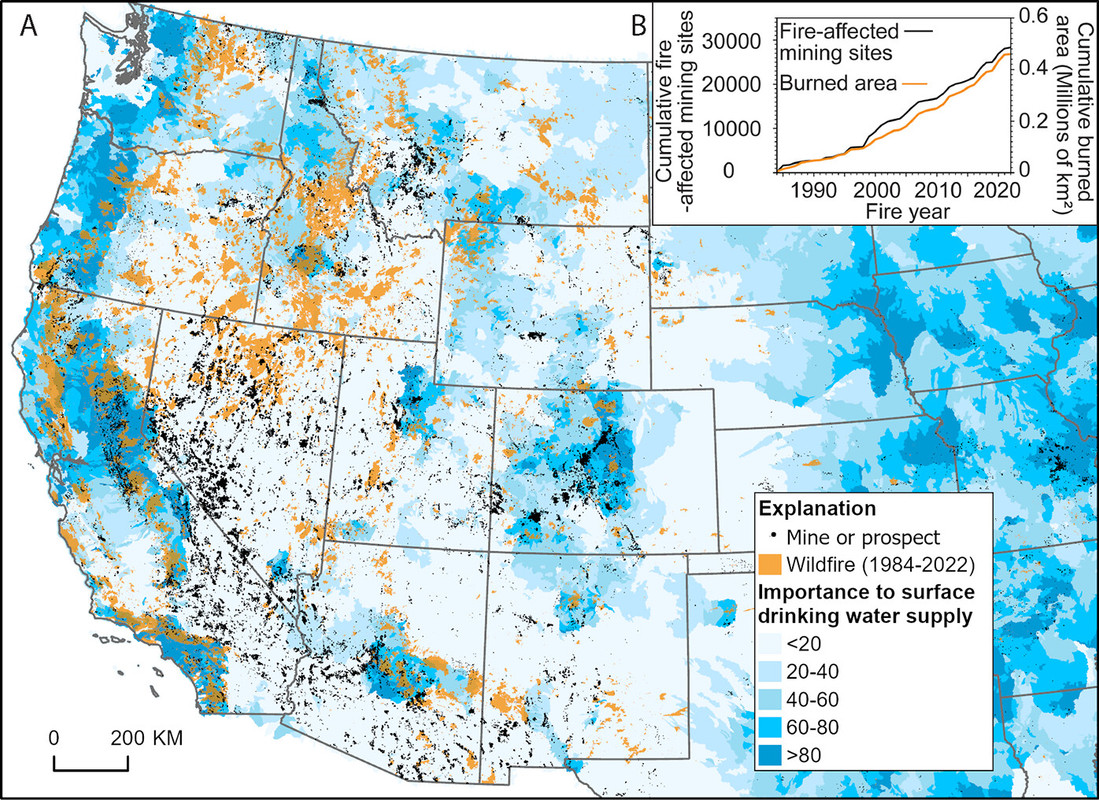Environment & Energy
Related: About this forumInteraction of Wildfires and Legacy Mining on Water Quality.
The paper to which I will briefly refer is this one: Intersection of Wildfire and Legacy Mining Poses Risks to Water Quality Sheila F. Murphy, Johanna M. Blake, Brian A. Ebel, and Deborah A. Martin Environmental Science & Technology 2025 59 (1), 35-44
It's open access, anyone can read it, so I won't spend a lot of time with it, just a few excerpts, a graphic and a comment.
The comment: There is a widespread belief that we're going to mine our way out of the extreme global heating we are now experiencing. This is the unsupportable belief that so called "renewable energy" is "green," despite its heavy land and material demands, the latter of import here. Even the intellectually and morally suspect antinuke Benjamin Sovacool, hardly my favorite person on a burning planet, understands this. (His "solution" is to tear the shit out of the ocean floor: Sustainable minerals and metals for a low-carbon future. What an asshole!)
Well, despite Benji's call to rip the shit out of the ocean floor (undoubtedly using fossil fuel powered dredges), it turns out that mining is, um, not good for water. Who knew?
The effect of squandering trillions of dollars on so called "renewable energy" is only to make things get worse faster.
Of course, it's not like antinukes give a rat's ass about the environment. Clearly they don't.
From the paper's text:
Mining and wildfires are two major disturbances that can have substantial impacts on downstream water quality. Water discharged from mines can have extreme pH and (or) be rich in metals (and metalloids, grouped here with metals), (16) and metal-rich mine waste can be transported 10s to 100s km downstream and stored for extended periods (1,000–100,000 years) in floodplains and lake sediments. (17−22) Mining-affected floodplains are now the primary source of metals to rivers in the United States (U.S.) and western Europe. (22) These metals are being remobilized by floods, (19,22,23) and due to predicted increases in rainfall intensity, flooding-driven redistribution of mining-affected floodplain sediment will likely worsen in the future. (18,24,25) Wildfires can lead to enhanced erosion and sediment transport and subsequent increases in sediment, nutrients, and metals in downstream waters, (26,27) resulting in stream habitat degradation and inflated water treatment costs. (5,28,29) Downstream effects may extend for 100s of km (30−32) and last more than a decade. (29,33−35) Modeled projections suggest that a third of western U.S. watersheds will have >100% more sedimentation by 2050 because of wildfire. (36)
Wildfires are now burning in mining-affected watersheds in many areas of the world, including North America, (37−41) South America, (42) Australia, (43−46) Europe, (47) Asia, (48) and Africa. (49,50) In the western U.S., the intersection of these hazards often coincides with important surface water supply watersheds (39,40,46) (Figure 1), with substantial water-quality and land management implications. For example, wildfire in a legacy mining area in Colorado led to elevated stream concentrations of arsenic for at least five years after the fire (39) and required removal of a ∼70-year-old arsenic- and lead-rich tailings deposit to protect downstream water supplies. (51) A postfire debris flow in Montana mobilized mine waste into a stream, leading to a multimillion-dollar cleanup effort. (38,52) Observed and anticipated increases in extreme wildfire behavior and severity, (53) in concert with amplification of storm intensity in many parts of the world, (54,55) suggest that the intersection of wildfire and mining and subsequent risk to water supplies may worsen. Previous work described potential pathways of metals to surface water in areas affected by wildfire and legacy mining. (39) The objective of this work is to connect current concepts about remobilization of legacy mine waste (18,22,56−58) with recent advances in understanding how wildfire affects landscapes and thus the erosion, mobilization, and transport of sediment. (59−62) We also illustrate the hazards to water supplies posed by the wildfire-accelerated mobilization of mining-derived metals in the western U.S. and identify challenges and opportunities for targeted research...
A graphic from the paper referring to the water stressed Western United States.

The caption:
The authors of the paper are with the USGS. Look for them to be fired for telling the truth in the age of King Eloon, cobalt mining slave holder.
Enough said.